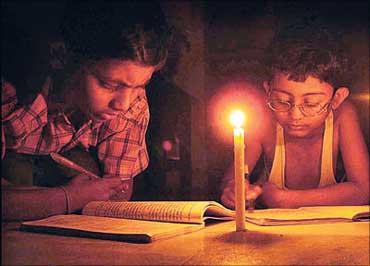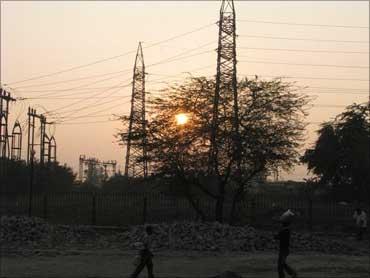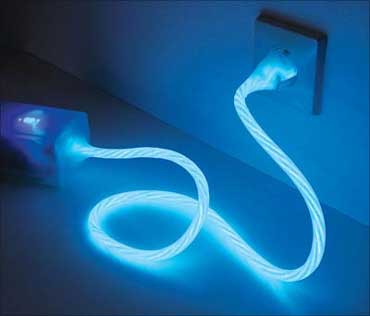
The problem lies in the fact that unlike in telecom, centre- and state-owned public utilities continue to dominate the power business.
Kolkata, June, World Cup 1990: Italy and Uruguay kicked off a game in the knockout stage of the tournament and denizens in this football-obsessed city settled down to enjoy a virtuoso display from two of the most elegant teams of that era.
Their anticipation was short-lived. Within minutes from kick-off at midnight India time, the entire city blacked out.
By the next morning, power wasn't back and it soon dawned on everyone that this wasn't a severe case of "load-shedding" - the term used to describe power shutdowns to deal with excess demand - but something more serious.
It was, and it heralded a new problem in West Bengal's chronic power crisis. Investigations revealed that the breakdown had been the result of Bihar overdrawing its quota from the eastern grid, causing a region-wise crisis.
This was the first time ordinary consumers got to hear of the concept of power overdrawals by competing state utilities, though they soon became familiar with it (power was restored at 9 pm the next day).
...

New Delhi, June, World Cup 2010: Portugal and Ivory Coast kicked off their Group G match in Port Elizabeth on a day when power had been fluctuating alarmingly.
Within minutes of kick-off, South Delhi blacked out. This time, there was an option in the form of the nearest five-star hotel, equipped with powerful back-up systems, which showed the game on a giant screen in its coffee shop.
Even this solution was not without its problems. Power came and went, requiring breaks for the projector to reboot - agonising for anyone watching a game in which a second can change a team's fortunes. Luckily, this was one of the most boring, scoreless matches of the tournament, so fans didn't miss much.
The next day newspapers spoke darkly of how various northern states were not observing "grid discipline" as a result of which Delhi had to go without power for long stretches, leaving a lingering anxiety about the possibility of watching the rest of the World Cup seamlessly.
In turn, the neighbouring states complained that increasing drawals to feed the national Capital's greedily expanding demand were depriving their cities of power and preventing farmers from irrigating their fields.
...

Two decades, two cities, same problem. Any way you look at it, and despite two decades of power reforms, the dimensions of the crisis haven't changed significantly for the ordinary consumer.
Ironically, power reform predated by several years telecom reform that, despite an uneven regulatory regime, has fundamentally transformed the life of ordinary citizens.
In the days when most people struggled to acquire telephone connections or make a call when they had them, solutions to rampant electricity theft, under-recoveries on electricity sales and non-performing state electricity boards were being implemented and discussed in the public domain.
Successive Central governments willingly acquired a collective blindness to the obvious defects of Enron's investment in Dabhol - India's largest project at the time - purely on the basis of a growing supply-demand gap, and laws (the Electricity Act of 2003) were passed to ease private investment.
Yet, despite all this assiduous attention, the Indian consumer remains hostage to chronic shortages (the industry has largely found a solution in captive sources) as the gap between targets and achievements steadily widens.
The record on generation is a case in point. Over the eighth, ninth and tenth Plans (1992-2007) - the period that roughly covers the start of reform to the present - achievements in adding generation capacity have hovered between 47 and 51 per cent.
...

The record for the current 11th Plan (2007-12) is no different. This is significantly below the 96 per cent achievement in the seventh Plan (1985-89) and 72 per cent in the Plan before.
Perhaps the problem lies in the fact that unlike in telecom, Centre- and state-owned public utilities continue to dominate the power business.
The fact that they account for 77 per cent of installed capacity can be dismissed as a historical legacy, but it is significant that the government sector accounts for 80 per cent of capacity additions in the current Plan and open access, which could introduce a modicum of competition in the sector, is a distant reality.
And where the problems of power theft, non-paying electricity boards etc. were the issues in the early 90s, prospective investors, private and government, now complain of fuel linkages, project finance and equipment shortages.
Obviously, the frivolous business of watching football matches without interruption is the least of the Indian consumer's problems.
The two incidents cited at the start of this piece merely serve as two markers to highlight a basic, unsolved problem in a country that now excitedly markets itself as the world's fastest-growing democracy. So, maybe Brazil 2014 would be a good time to reassess the situation.